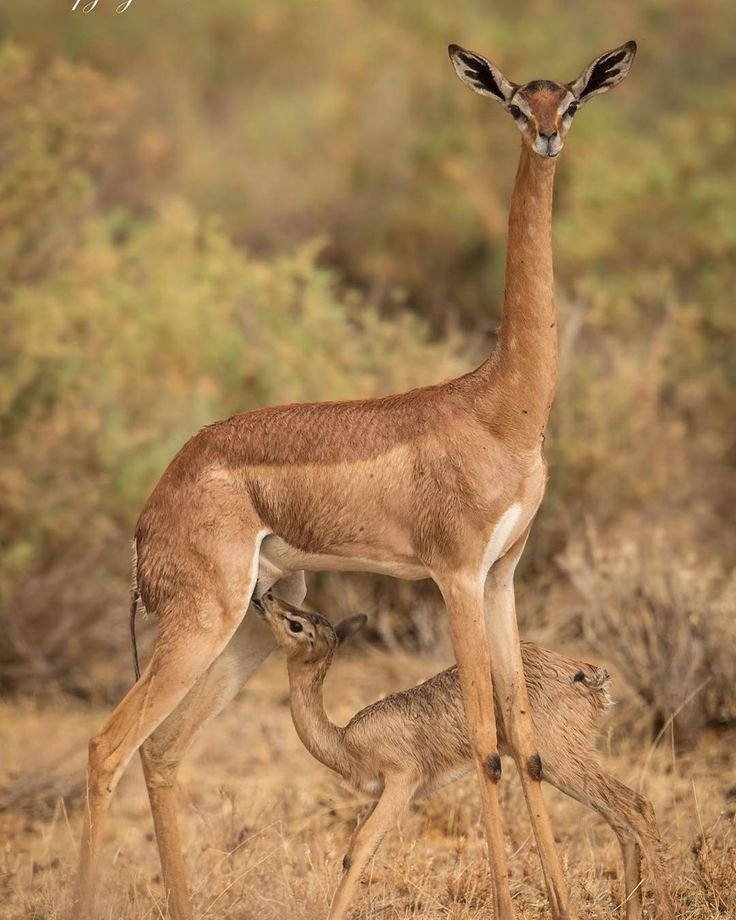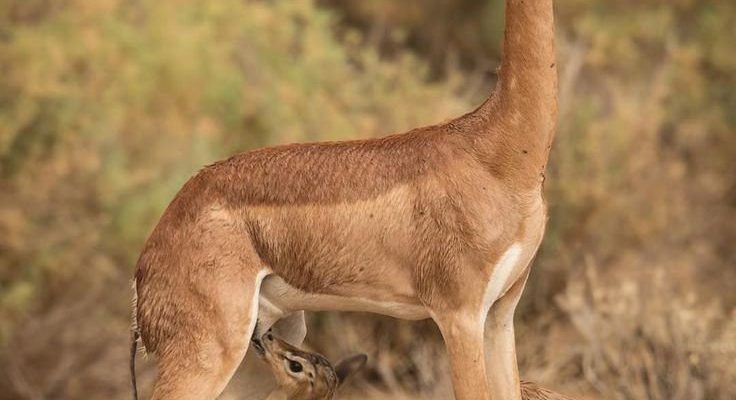
Raising young in the wild is no walk in the park, especially for a species like the gerenuk. Imagine trying to protect your little ones in a world filled with predators and scarcity. Gerenuks have developed their own strategies and behaviors for parenting that help their fawns thrive amidst challenges. So, let’s dive into the world of gerenuks and explore the incredible journey of raising their young!
Where Gerenuks Live
Gerenuks primarily inhabit the arid and semi-arid regions of East Africa, including countries like Kenya and Tanzania. These areas can sound harsh, with dry savannahs and tough scrublands. Yet, they also have a unique beauty and are home to many fascinating species. Gerenuks have adapted beautifully to these environments, making them a common sight in the bush.
These animals prefer a habitat that offers plenty of browsing options. They tend to hang around acacia trees and other shrubs, where they can snack on tender leaves and shoots. Notice how their long necks come into play here? These giraffe-like features allow them to reach high branches that other grazers can’t. It’s like having a built-in advantage, letting them thrive even when food is scarce.
Their habitat can be quite a challenge, especially when it comes to raising young. The dry conditions mean that water sources can be limited, and the threat of predators like lions and leopards is always lurking. Knowing how to effectively raise their young in such a demanding setting is crucial for the survival of the species.
The Mating and Gestation Process
Gerenuks typically enter their mating season during the rainy periods when food is more abundant. Males often compete for the attention of females, showcasing their strength and agility through displays that could rival an Olympic athlete. It’s not just about showmanship; the strongest males have a better chance of passing on their genes, ensuring that only the fittest survive.
Once a female has mated, she undergoes a gestation period of about seven months. That’s around the same time it takes for a human! During this time, the mother is careful to find a safe place where she can give birth. It’s usually hidden in dense bushes or tall grass, away from the watchful eyes of potential predators. Think of it as setting up a little nursery in the wild—one that’s both cozy and secure.
When the time finally comes, the female will usually give birth to a single fawn. Twins are rare in gerenuks, likely because raising two at once would be quite the challenge in such a predator-rich environment.
Caring for the Newborn
The moment a fawn is born, it’s crucial that it gets the right care. Gerenuk fawns are surprisingly agile. Within just a few hours, they can stand and begin walking. However, the mother keeps them close to ensure they stay safe. She’ll often hide her little one in dense cover, returning periodically to nurse. This helps prevent attracting unwanted attention from predators.
At first, the fawn’s primary diet consists of its mother’s milk. This superfood is packed with all the nutrients the baby needs to grow strong. As the fawn matures, it will gradually start nibbling on the same tender leaves and shoots that its mother eats.
To support the fawn during its crucial first weeks, mothers will often choose to remain solitary. This is an interesting strategy, as hiding the fawn away from the herd reduces the chances of predators discovering them. It’s definitely a balancing act—keeping the fawn safe while also ensuring that it’s learning how to forage when the time comes.
The Role of the Mother
The mother gerenuk plays an essential role in her fawn’s development. She’s not just a caretaker; she’s a teacher. As the fawn grows, the mother will show it how to find food and recognize signs of danger. You might think of her as a savvy, seasoned guide, leading her young one through the complexities of their environment.
One remarkable aspect of the mother’s role is her ability to communicate with her fawn. She uses soft vocalizations and gentle nudges to establish a bond and create a sense of security. This strong maternal connection is critical, especially in the early stages of life when the fawn is most vulnerable.
Over time, the mother will encourage her fawn to be independent. She’ll start leaving it for short periods to graze or drink. This gradual separation helps the fawn build confidence and learn vital survival skills, preparing it for life on its own.
Challenges Gerenuks Face
Raising young in the wild isn’t without its challenges. Gerenuks face a range of threats—from predators lurking in the shadows to environmental stresses like drought. One of the biggest dangers comes from large carnivores that may see a fawn as an easy meal.
Additionally, changes in their habitat due to human activities can impact their survival. Deforestation or encroachment on their territories can limit their food sources and safe spaces for raising young. When the environment shifts, animals like gerenuks must adapt quickly, or risk losing their offspring.
Moreover, with climate change leading to unpredictable weather patterns, finding reliable food and water has become even trickier. It’s a tough world out there, and every gerenuk mother must strategize to keep her young safe and nourished.
Social Structure and Gerenuk Groups
Gerenuks are generally social animals, and they tend to gather in small groups. This social structure can provide extra protection for mothers and their fawns. When several gerenuks come together, they can keep an eye out for potential threats, like lurking predators. It’s a bit like forming a neighborhood watch group—everyone looks out for each other!
However, while they might hang out in groups, females with young fawns tend to be more solitary. This behavior helps ensure that the fawn is less likely to attract attention. Once fawns reach a certain age and show they can keep up, they’re often incorporated back into the group.
There’s something fascinating about this mix of socialization and independence that helps ensure the survival of both the mothers and their young. By sharing the landscape and alerting one another to danger, they enhance each other’s chances in the wild.
The Journey to Independence
As the fawn grows, it gradually learns to navigate the wild on its own. This transition usually takes about six months, at which point the fawn is weaned off its mother’s milk. It begins to rely more on foraging and developing its own foraging skills.
During this time, the mother remains a key figure. She’ll continue to monitor her young one, offering guidance and support while allowing it to practice independence. It’s like a parent teaching their child to ride a bike—balancing support with the need for autonomy.
By the end of the first year, the young gerenuk is ready to venture out and find its own territory. This journey is crucial for its survival and the continuation of the species. Each new generation brings its own set of experiences and adaptations, contributing to the unique story of the gerenuk in the wild.
Raising young in the wild is a delicate dance filled with challenges and triumphs. For gerenuks, it’s not just about survival; it’s about nurturing the next generation in a world where every day is an adventure. From their unique parenting strategies to forming social bonds, these animals have developed remarkable ways to adapt and thrive.
The journey from fawn to independence reflects the broader circle of life in the wild. Each gerenuk plays a part in this intricate ecosystem, ensuring the survival of their species against all odds. It’s a beautiful reminder of how life continues, even in the face of adversity. So, the next time you think of gerenuks, remember their incredible story of raising young—their resilience, strength, and the lessons they pass on to the next generation.

